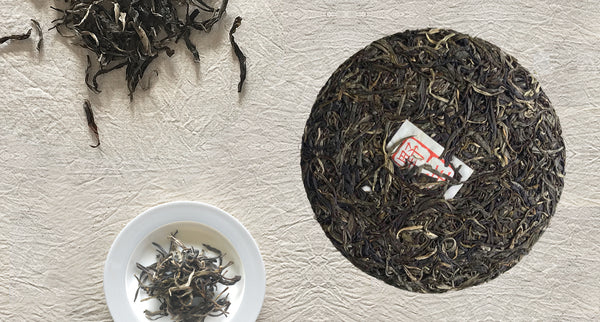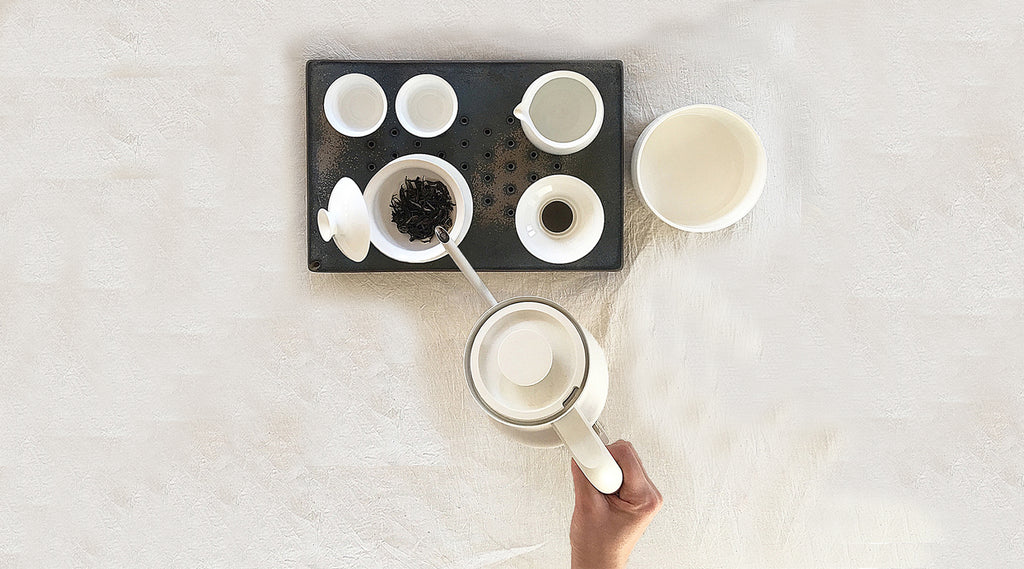Pu-erh Tea Caffeine Content by Type and Age
Reading time: 6 minutes
Does pu-erh tea have more caffeine than other teas? How does the caffeine content change as the tea ages? What about raw vs. ripe pu-erh?
As a tea sommelier, I get these questions asked time and time again, likely due to the amount of misinformation out on the Internet.
In short, yes. All teas from the Camellia sinensis plant contain naturally-occurring caffeine. Tisanes, or herbal teas, are the only truly decaffeinated “teas” available.
But how much exactly? Let's dive into the specific caffeine content of pu-erh tea.
This post is part of our Aged Tea 101 series. Sign up to get the full series!
The assumption about the caffeine content of pu-erh tea
Many people say that raw pu-erh has higher caffeine content and therefore it is better suited for the day, and that ripe pu-erh has lower caffeine content and therefore is better suited for the evening.
Some people assume that darker the brewed tea color, the more caffeine it contains.
All these assumptions are simply NOT true. The type of tea (i.e. white, green, yellow, oolong, black, dark) does NOT determine its caffeine content. For example, black teas do NOT necessarily contain more caffeine than green teas.
When researchers compared the caffeine content across all types of teas, they found no correlation between the type of tea and the determined caffeine content. Their results were published in the Journal of Analytical Toxicology in 2008.

Factors that influence the caffeine content of pu-erh tea
Then, what influences the caffeine content? Here are the different factors that determine the caffeine content.
1. Age of Tea Leaves
Teas that contain new buds and/or very young leaves contain a higher level of caffeine. That is because caffeine is a natural insecticide for young buds and leaves to protect them from insects.
That means if you have a high-quality pu-erh tea cake with lots of buds, it will contain more caffeine.
2. Type of Tea Plant
All teas come from the tea plant Camellia sinensis, but there are different subspecies, varietals, and cultivars of this tea plant. Even for pu-erh tea, which uses Camellia sinensis var. assamica from Yunnan province as its raw material, there are more than 20 varietals just in this region.
As each varietal has different levels of caffeine, we cannot generalize the amount of caffeine across all pu-erh tea.
3. Processing of the Tea
Wet-piling process, the process in which all ripe pu-erh goes through to encourage bacterial and fungal fermentation, leads to higher levels of caffeine and lower levels of antioxidants based on this scientific research.
Therefore, when compared to raw pu-erh aged without piling and dampening, ripe pu-erh contains higher levels of caffeine.
4. Age of the Tea
Because the post-fermentation process breaks down the caffeine present in the pu-erh leaves, aging the tea decreases the caffeine content. Therefore, the longer the pu-erh teas are aged, the less caffeine they will contain.
This means that young raw pu-erh (also called sheng pu’er) aged less than two or three years will have more caffeine than raw pu-erh aged for five or ten years. Pu-erh teas that are allowed to age for fifteen, twenty or even thirty years will contain less and less caffeine with age.
5. Brewing Process
This is one of the most important factors, and it’s also the one you have control over.
Did you know that the tea plant contains more caffeine than coffee beans? But brewed tea generally has less caffeine than brewed coffee. It’s all about dilution and brewing practices!
Brewing times and methods can affect how much caffeine makes the journey from leaf to cup. Here are different brewing parameters and how they affect the caffeine content.
- Brewing temperature: Higher the brewing temperature, more caffeine will be extracted out from the leaves into your brewed tea.
- Brewing time: Longer you brew the tea, more caffeine will be extracted out from the leaves into your brewed tea.
- Amount of leaves: And as you expected, the more leaves you use, the higher the caffeine amount per cup.
Typically, when using the gongfu style, both raw and ripe pu-erh teas are brewed with a lot of tea leaves using hot water or boiling temperature water with short infusions. Because of a large amount of tea brewed in this process, gongfu tea sessions can lead to higher overall caffeine consumption.
If you are brewing pu-erh tea using an infuser or a large teapot, you might be using lower temperature water to brew your raw pu-erh (vs. boiling temperature water for ripe pu-erh). In this case, keeping all other brewing parameters the same, i.e. amount of tea and brewing time, there would be less caffeine in your cup.
In the case of cold-brewed tea, because you use lower temperature water but a longer timeframe, it does not necessarily have lower caffeine content.
The caffeine content of pu-erh tea: raw or ripe pu-erh
So based on these factors, if we were to roughly rank different pu-erh teas from the highest to the lowest caffeine, it would be as follows:
- Young ripe pu-erh tea with buds and young leaves (highest caffeine content)
- Young raw pu-erh tea with buds and young leaves
- Young ripe pu-erh tea with mature leaves
- Young raw pu-erh tea with mature leaves
- Aged ripe pu-erh tea with buds and young leaves
- Aged raw pu-erh tea with buds and young leaves
- Aged ripe pu-erh tea with mature leaves
- Aged raw pu-erh tea with mature leaves (lowest caffeine content)
Note that this is an estimate as we don’t know whether the effect of aging is greater than the effect of buds and young leaves.
Reason tea companies list pu-erh tea as high in caffeine
So why have been told that pu-erh tea contains more caffeine than white or green tea?
When big companies test the amount of caffeine in their tea, they usually test their brewed cup of tea.
This means that they use their version of pu-erh tea (i.e. cheaper young ripe pu-erh), and their brewing parameters (i.e. boiling temperature for pu-erh vs. lower temperature for white and green tea). Therefore, when they compare the caffeine content between pu-erh tea and other teas, pu-erh tea has higher caffeine content.
Smaller handcrafted tea companies like us do not have the capital to test each batch of our tea for its caffeine content. So we simply do not know the exact number.
Effects of Caffeine in Tea
According to the study, the safe caffeine intake is 400 mg of caffeine per day. Given that pu-erh tea is lower in caffeine than coffee, you can drink more volume of tea than coffee for the same amount of caffeine. Pu-erh tea also has additional benefits, such as decreasing risk of heart disease.
While these generalized statements about caffeine content are a good place to start when determining the amount of caffeine in your preferred selection, it’s best for tea lovers to remember that everybody responds differently to caffeine.
Also, caffeine from tea works differently from caffeine from coffee because tea contains L-theanine, an amino acid that regulates the rate at which our body absorbs caffeine.
If you are sensitive to caffeine, try testing out your new tea in small amounts or in the early morning to see how your body responds. Of course, if you have any condition, it is important to consult your physician.
This post is part of our Aged Tea 101 series. Sign up to get the full series!












































![[Phoenix 2019] Dancong Oolong](http://mansatea.com/cdn/shop/products/songshong_on_template_{width}x.jpg?v=1564767249)
![[Phoenix 2019] Dancong Oolong](http://mansatea.com/cdn/shop/products/duck_shit_on_template_{width}x.jpg?v=1564767249)


























